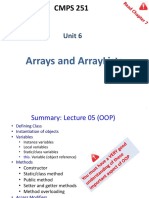0 ratings0% found this document useful (0 votes)
27 viewsArrays and Collections in Java
Uploaded by
nnaveenjaimmCopyright
© © All Rights Reserved
Available Formats
Download as PDF, TXT or read online on Scribd
0 ratings0% found this document useful (0 votes)
27 viewsArrays and Collections in Java
Uploaded by
nnaveenjaimmCopyright
© © All Rights Reserved
Available Formats
Download as PDF, TXT or read online on Scribd
You are on page 1/ 2
Arrays and Collections in Java
Arrays in Java
Definition: Arrays are a fixed-size, homogeneous data structure in Java, meaning they store
elements of the same data type.
Key Features:
- Fixed size: Once defined, the size of an array cannot change.
- Zero-based index: Array indexing starts at 0.
- Homogeneous elements: Only elements of the same type can be stored.
Declaration:
int[] numbers = new int[5]; // Declares an array of integers with size 5
int[] numbers = {1, 2, 3, 4, 5}; // Declaration and initialization
Accessing Elements: Using index, e.g., numbers[0] gives the first element.
Common Operations:
- Iteration: Using for loop or enhanced for-each.
- Sorting: Using Arrays.sort(array) for sorting.
- Copying: Using Arrays.copyOf() for duplicating arrays.
Collections in Java
Definition: Collections in Java are flexible data structures that can store a dynamic number of
elements.
Key Features:
- Can grow or shrink in size dynamically.
- Offers a variety of implementations (List, Set, Map).
- Supports various operations like sorting, searching, and modifying.
Hierarchy:
- List: Ordered collection (e.g., ArrayList, LinkedList).
- Set: Unordered collection with unique elements (e.g., HashSet, TreeSet).
- Map: Key-value pairs (e.g., HashMap, TreeMap).
Common Operations:
- Add, Remove, and Retrieve: add(), remove(), get().
- Iteration: Using Iterator, for-each, or streams.
- Sorting: Collections like List can be sorted using Collections.sort().
You might also like
- Hourglass Workout Program by Luisagiuliet 276% (21)Hourglass Workout Program by Luisagiuliet 251 pages
- Read People Like A Book by Patrick King-Edited57% (82)Read People Like A Book by Patrick King-Edited12 pages
- Livingood, Blake - Livingood Daily Your 21-Day Guide To Experience Real Health77% (13)Livingood, Blake - Livingood Daily Your 21-Day Guide To Experience Real Health260 pages
- Donald Trump & Jeffrey Epstein Rape Lawsuit and Affidavits83% (1016)Donald Trump & Jeffrey Epstein Rape Lawsuit and Affidavits13 pages
- The 36 Questions That Lead To Love - The New York Times91% (35)The 36 Questions That Lead To Love - The New York Times3 pages
- The 36 Questions That Lead To Love - The New York Times95% (21)The 36 Questions That Lead To Love - The New York Times3 pages
- Jeffrey Epstein39s Little Black Book Unredacted PDF75% (12)Jeffrey Epstein39s Little Black Book Unredacted PDF95 pages
- 14 Easiest & Hardest Muscles To Build (Ranked With Solutions)100% (8)14 Easiest & Hardest Muscles To Build (Ranked With Solutions)27 pages
- The 4 Hour Workweek, Expanded and Updated by Timothy Ferriss - Excerpt23% (954)The 4 Hour Workweek, Expanded and Updated by Timothy Ferriss - Excerpt38 pages
- Data Structures Arrays, Lists, Sets, MapsNo ratings yetData Structures Arrays, Lists, Sets, Maps1 page
- Collections: (An Easy Way To Manage Objects)No ratings yetCollections: (An Easy Way To Manage Objects)9 pages
- What Is Array: - An Array Is A Container Object That Holds When The Array Is Created. After Creation, Its Length Is FixedNo ratings yetWhat Is Array: - An Array Is A Container Object That Holds When The Array Is Created. After Creation, Its Length Is Fixed25 pages
- OOPJ-1.4 E-Learning PowerPoint TemplatesNo ratings yetOOPJ-1.4 E-Learning PowerPoint Templates9 pages
- Uint-I(Array,String,Vector) (Autosaved)No ratings yetUint-I(Array,String,Vector) (Autosaved)23 pages
- Apznzabrhwleihg81eirvirzpf-5y7m5ynf73ynoqedmsjf4 Nfvlifwhcoccdwddxqyigmuqotvl8mysxuzqzsfogijh2l Bx 3rssopzd5in4yxdtb0gbvbrxuuypbyz5lw36d Fp3bqti7zm5nhwmwqi4iffc5cg6iaz1yh7p07sxbnzmxvh2taiznvpkifnw60ib856awstbjbwh6yNo ratings yetApznzabrhwleihg81eirvirzpf-5y7m5ynf73ynoqedmsjf4 Nfvlifwhcoccdwddxqyigmuqotvl8mysxuzqzsfogijh2l Bx 3rssopzd5in4yxdtb0gbvbrxuuypbyz5lw36d Fp3bqti7zm5nhwmwqi4iffc5cg6iaz1yh7p07sxbnzmxvh2taiznvpkifnw60ib856awstbjbwh6y60 pages
- Fall Semester 2024-25 - STS3004 - TH - AP2024252001206 - 2024-10-03 - Reference-Material-INo ratings yetFall Semester 2024-25 - STS3004 - TH - AP2024252001206 - 2024-10-03 - Reference-Material-I49 pages

























































































